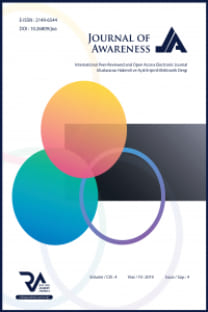ORTAÇAĞ’DAN MODERNİZME DEĞİŞEN FİKİRLER DOĞRULTUSUNDA BATI RESİM SANATINDA GÜZELİ ARAYIŞ
"Sanat" ve bazen ona eşlik eden "güzellik" hiç bir zaman basitçe tanımlanabilen konular olmamıştır. Dönemlerin değişiklik gösteren sosyolojik, ekonomik, kültürel ve politik parametreleri ile sanatın unsurları, amaçları, düşünsel ve toplumsal statüsü değişiklikler göstermiş, sanatçılar bununla bağlantılı olarak farklı arayışlar içinde olmuş ve farklı estetik yaklaşımlar ortaya koymuşlardır. Ortaçağ sanatı tamamen dine hizmet eder ve güzelliği sanatla ilişkilendirilmesi gereken bir unsur olarak görmezken, Rönesans güzeli tamamen sanatla bağlantılı bir şekilde antik mirasta aramıştır. Ancak bu dönemde de resmin eğitici, öğretici bir anlatım içermesi gerekliliği temel koşuldur ve resmin konusu kutsal kitaba, diğer kutsal, tarihsel, edebi, hatta kurmaca metinlere dayanmaktadır. On sekizinci yüzyıla kadar durum benzer şekilde devam etmiş, saptanan ve tesadüfen aşılan sınırların ötesine ancak on sekizinci yüzyılda geçilebilmiştir. Bu yüzyılın başlangıcı ile birlikte görsel sanatların metinsel niteliklerinden uzaklaşarak benzersiz nitelikleri ile ilgilenilmeye başlanmış ve bu yaklaşım yirminci yüzyıl modernizminin önemli bir bölümünü etkisi altına almıştır. Modern yaklaşımda resim plastiğin temel unsurları çerçevesinde analiz edilmektedir. Her dönemde değişen fikirler doğrultusunda düşünürler ve sanatçılar güzelliği ve sanatı tanımlamaya ve değerlendirmeye çalışmışlardır. Bu çalışma Ortaçağ’dan Yirminci Yüzyıl’a bu değerlendirmeleri Batı resim sanatı üzerinden incelemeyi amaçlamaktadır.
Anahtar Kelimeler:
Resim Sanatı, Güzel, Estetik
SEARCHING FOR BEAUTY IN WESTERN PAINTING IN THE LIGHT OF IDEAS CHANGING FROM MEDIEVAL AGE TO MODERNISM
“Art” and the accompanying “beauty” have never been topics that might be defined easily. The elements, purposes, ideational and social status of art have been in a continuous change as sociological, economical, cultural and political parametres of every era evolves; and artists have been in search of different pointof views and in consequence, have introduced different aesthetic approaches. While the medieval art of the Western world serves completely for religious purposes and does not consider beauty as an element to be related to art; the Renaissance seeks the beauty as a component of art in cultural heritage. However, the necessity for the painting to have an educative and didactive expression is the fundamental rule for this era and the subject of painting is usually based on the Bible and other holy, historical, literal, and even fictional manuscripts. This situation persists in a similar manner until the eighteenth century; to move beyond borders that were detected and crossed accidently was only possible in the eighteenth centrury. From the beginning of this century, visual arts detract from textualism and people become more attacted to its unique qualities, and this approach exercised a great influence on the modernism of twenty-first century. In the modern approach, painting is analyzed within the frame of basic elements of plastic. Philosophers and artists from every era have tried to define and interpret art in the light of ever-changing ideas of every era. The aim of this article is to analyse these interpretations over the Western painting from the Medieval age to Twenty-First Century
Keywords:
Painting Art, Beautiful, Aesthetic,
- ISSN: 2149-6544
- Başlangıç: 2016
- Yayıncı: Rating Academy
Sayıdaki Diğer Makaleler
UZAKTAN TÜRKÇE DERSLER ALAN BATI TRAKYALI TÜRK ÖĞRENCILERIN KENDILERINI DEĞERLENDIRME ÇALIŞMASI
Abdullah ŞAHİN, Esin Yağmur ŞAHİN, Gülnur AYDIN, Mesout Kalın SALI, Kübra EMRE, Numan YILDIRIM
MEKANİK İŞLEVİNİN ÖTESİNDE ESTETİK BAĞLAMINDA “ SİNEMADA KURGU”
TÜRKİYE DIŞ TİCARETİNDE DÖVİZ KURU BELİRSİZLİĞİ
Nur Dilbaz ALACAHAN, Yağmur AKARSU
Karaz Seramikleri Örnekleri Işığında Geleneksel Kültür Nesnesinden Estetik Kategoriye Geçiş
"Seramik Tasarımında Güzeli Arayış Sürecinde Yerel Değerlerin Esin Kaynağı Olarak Kullanımı"
ORTAÇAĞ’DAN MODERNİZME DEĞİŞEN FİKİRLER DOĞRULTUSUNDA BATI RESİM SANATINDA GÜZELİ ARAYIŞ
